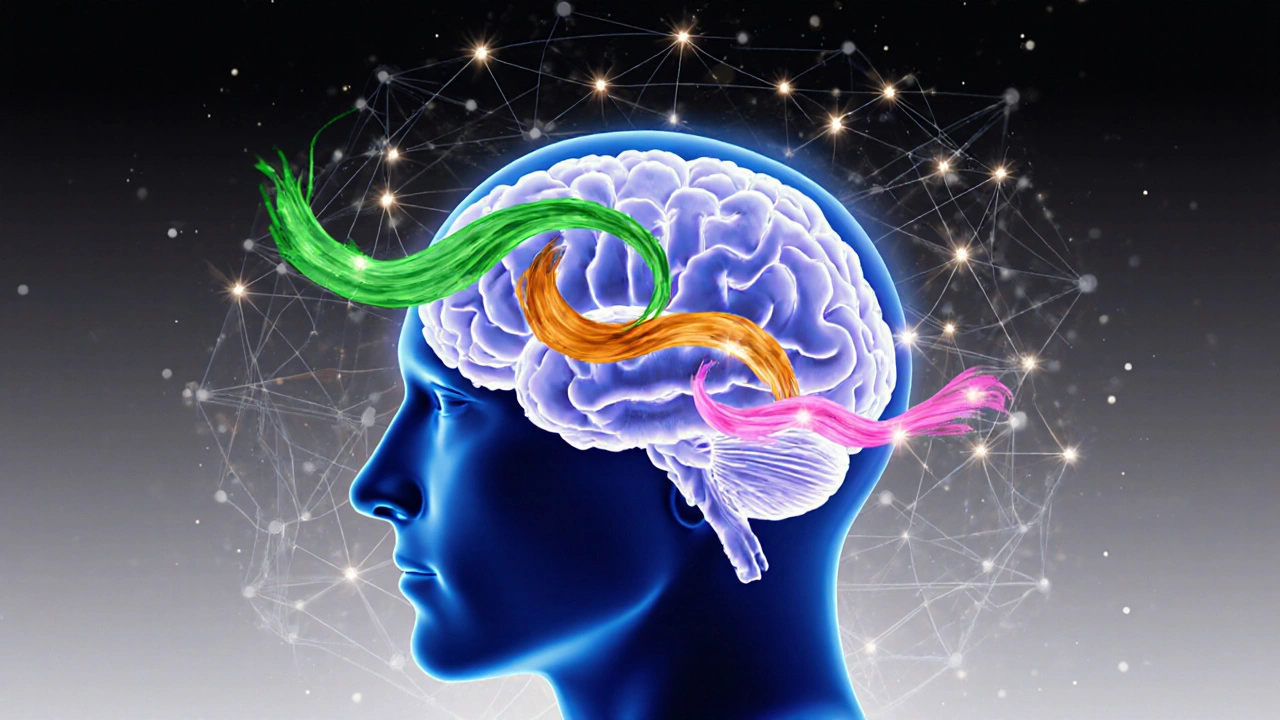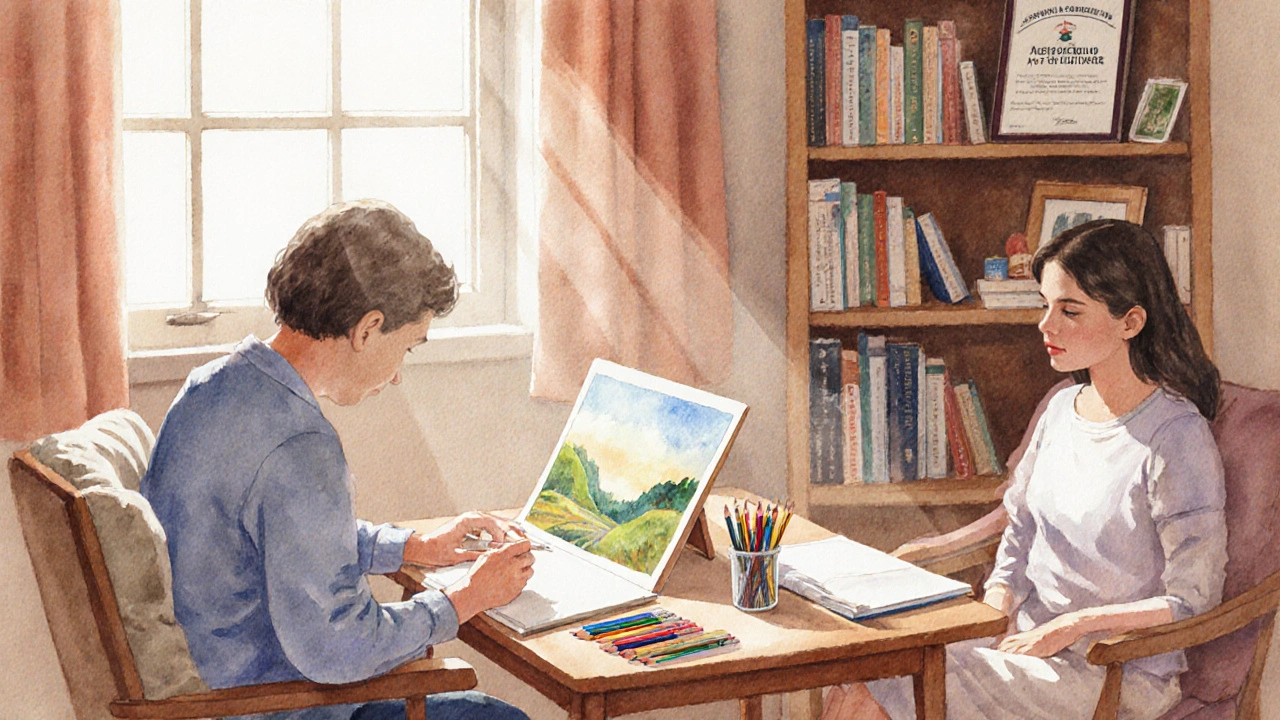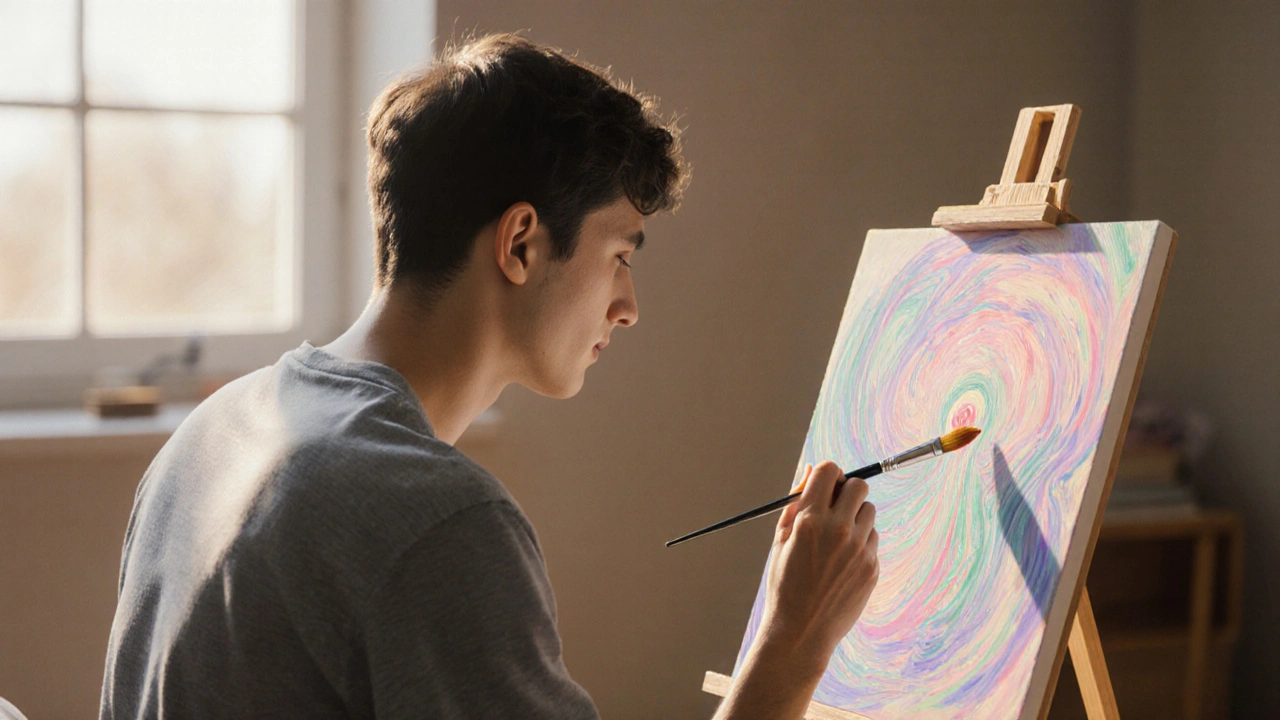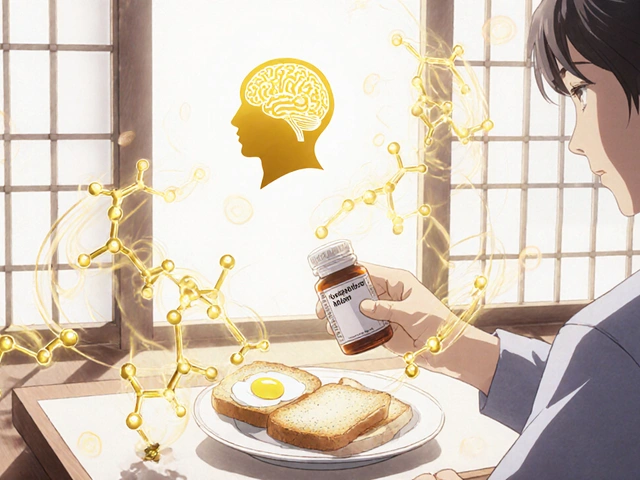Art Therapy Benefits Calculator
Estimated Benefits
Living with schizophrenia can feel like navigating a maze of thoughts, emotions, and social challenges. While medication and psychotherapy are standard pillars, many patients ask: can creativity play a role in healing? Art therapy offers a hands‑on way to tap into the brain’s natural repair mechanisms, giving people a outlet to process feelings and rebuild confidence.
Key Takeaways
- Art therapy uses guided creative activities to improve emotional regulation and social engagement in people with schizophrenia.
- Neuroplastic changes observed in studies show better cognitive function and reduced symptom severity after regular sessions.
- Evidence comes from randomized trials, meta‑analyses, and real‑world programs across hospitals and community centers.
- Successful integration requires collaboration between psychiatrists, art therapists, and families, plus clear treatment goals.
- Common pitfalls include unrealistic expectations, lack of trained facilitators, and neglecting cultural preferences.
What Is Art Therapy?
Art therapy is a psychotherapeutic practice that combines the process of creating visual art with guided reflection, aiming to improve mental health and well‑being. It is administered by certified art therapists who understand both artistic techniques and clinical psychology. The medium can be drawing, painting, collage, sculpture, or digital media, chosen to match a client’s abilities and interests.
Understanding Schizophrenia
Schizophrenia is a chronic brain disorder characterized by hallucinations, delusions, disorganized thinking, and social withdrawal. It typically emerges in late adolescence or early adulthood and affects about 1% of the global population. The condition involves dysregulation of dopamine pathways, altered gray‑matter volume, and impaired connectivity in frontal and temporal lobes.

Why Creative Activities Help
The brain’s ability to reorganize itself-known as neuroplasticity the capacity of neural networks to change through growth and rewiring in response to experience-remains surprisingly robust even in schizophrenia. Engaging in art activates several regions simultaneously:
- Prefrontal cortex: improves executive function and planning.
- Temporal lobes: aids memory and language processing.
- Limbic system: regulates emotions and reduces anxiety.
When a person paints or sculpts, they shift focus from intrusive thoughts to tactile sensations, fostering a state of “flow.” This immersion lowers cortisol levels, enhances mood, and creates a safe space for expressing feelings that words might not capture.
Evidence from Clinical Studies
Researchers have measured outcomes using standardized scales like the Positive and Negative Syndrome Scale (PANSS) and the Global Assessment of Functioning (GAF). Below is a snapshot of three landmark trials that examined art therapy as an adjunct to medication.
| Study | Design | Duration | Sample Size | Main Outcomes |
|---|---|---|---|---|
| Roth et al., 2020 (USA) | Randomized controlled trial | 12 weeks | 60 (30 art‑therapy + medication, 30 medication only) | PANSS negative symptoms ↓ 15%; GAF ↑ 10 points |
| Kumar & Singh, 2021 (India) | Multi‑site cohort | 6 months | 120 (all receiving standard care) | Improved social functioning scores ↑ 22%; reduced hospital readmission by 30% |
| Martinez et al., 2023 (Spain) | Meta‑analysis (5 RCTs) | Varied | Combined N=350 | Effect size d=0.45 for overall symptom reduction; strongest impact on emotional regulation |
These results consistently show modest but meaningful improvements in negative symptoms, social interaction, and quality of life when art therapy is added to pharmacological treatment.
Integrating Art Therapy into a Treatment Plan
Successful integration looks like a collaborative roadmap involving psychiatrists, art therapists, case managers, and family members. Below are practical steps to get started.
- Screen for interest and baseline cognitive ability; use a brief questionnaire to gauge comfort with visual media.
- Identify a certified art therapist a professional trained in both psychotherapy and visual arts, often holding a master's degree in art therapy who can tailor sessions to the client’s needs.
- Set clear goals (e.g., reduce agitation, improve self‑esteem, enhance communication) and document them in the patient’s care plan.
- Schedule weekly 60‑minute group or individual sessions, allowing room for both structured tasks and free‑form creation.
- Incorporate reflective discussion after each session, linking artwork themes to daily experiences and medication adherence.
- Monitor progress with standardized scales every 8‑12 weeks, adjusting session frequency based on observed benefits.
When the therapist works closely with the psychiatrist, medication side effects (such as sedation) can be managed to keep the patient engaged and motivated.

Practical Tips for Patients and Families
Even if you’re not attending a formal program, these simple ideas can bring the benefits of art therapy into daily life.
- Start small: Keep a sketchbook on the nightstand and doodle for five minutes before bed.
- Use familiar materials: Colored pencils or watercolors are less messy than oil paints and work well at home.
- Focus on process, not product: Celebrate the act of creating, not whether the picture looks “good.”
- Share safely: If you feel comfortable, discuss the artwork with a trusted friend or therapist to explore hidden emotions.
- Combine with mindfulness: Pair breathing exercises with painting to deepen relaxation.
Family members can support by setting up a quiet, well‑lit space, offering encouragement, and attending occasional sessions to understand the patient’s perspective.
Potential Pitfalls and How to Avoid Them
Like any therapeutic modality, art therapy can fall short if expectations are unrealistic or the setting isn’t right.
- Over‑promising quick cures: Art therapy complements, not replaces, medication. Frame it as a gradual skill‑building process.
- Misaligned therapist expertise: Ensure the facilitator holds recognized credentials (e.g., registration with the Australian Association of Art Therapists).
- Cultural mismatch: Artwork themes should respect the patient’s cultural background; ask about preferred symbols or colors.
- Neglecting safety: Some patients may become overly absorbed and skip medication doses. Regular check‑ins help keep treatment balanced.
Addressing these issues early can keep the program productive and prevent dropout.
Resources and Next Steps
For those ready to explore art therapy, the following resources provide reliable entry points:
- Australian Association of Art Therapists (AAAT) - offers a directory of certified practitioners across Australia.
- Local hospital psychiatry departments often run weekly creative‑arts groups; inquire with your case manager.
- Online platforms such as MindfulArt.org host guided video sessions tailored for mental‑health recovery.
- Books: “The Art Therapy Sourcebook” (2022) and “Creativity in Schizophrenia” (2021) compile case studies and step‑by‑step exercises.
Take the first step by speaking with your psychiatrist about adding a referral to a qualified art therapist. Even a single session can reveal how powerful visual expression can be in your recovery journey.
Frequently Asked Questions
Is art therapy covered by health insurance in Australia?
Many private health funds include “psychological services” that can cover art therapy when referred by a psychiatrist or general practitioner. Public mental‑health services in most states also provide community‑based art‑therapy groups at no cost.
Can art therapy help with hallucinations?
While art therapy does not directly eliminate auditory or visual hallucinations, it can reduce their distress by offering alternative focus and helping patients reinterpret the experience through symbolic artwork.
Do I need any artistic skill to benefit?
No. The therapeutic value comes from the act of creating, not the quality of the final piece. Therapists tailor activities to each person’s comfort level.
How often should I attend sessions?
Research suggests weekly 60‑minute sessions for at least three months yield measurable gains. Frequency can be adjusted based on individual response and scheduling.
What if I feel uncomfortable sharing my artwork?
Therapists respect privacy and can keep the artwork confidential. Sharing is optional and usually encouraged only when the client feels ready.






Wow, the way art therapy taps into neuroplasticity is fascinating. I’ve seen workshops where even a simple doodle helped a participant calm down after a stressful day. It’s amazing how the act of creating can rewire some of those disordered pathways. Keep spreading the word – more people need to know this gentle yet powerful tool.
This summary nails the key points – art therapy really does boost social skills and mood stability. A concise reminder that creativity isn’t just a hobby, it’s a therapeutic ally.
Sure, because painting a sunset will instantly fix all delusions, right? In reality, it’s a nice supplement, not a miracle cure. Still, any activity that pulls someone out of a spiral is worth a try.
Art therapy’s impact on schizophrenia recovery can be understood through several interlocking mechanisms. First, the tactile engagement in drawing or sculpting activates the prefrontal cortex, which is often under‑active in patients, thereby improving executive functions such as planning and impulse control.
Second, the limbic system, responsible for emotional regulation, receives soothing sensory input during the creative process, which lowers cortisol levels and reduces anxiety spikes. Third, the temporal lobes, which handle auditory and language processing, are stimulated when patients interpret visual metaphors, helping them organize fragmented thoughts.
Beyond the neurobiology, there is the psychosocial benefit: group art sessions create a low‑stakes environment for social interaction, allowing participants to practice communication without the pressure of conventional conversation. This can gradually erode the social withdrawal that characterizes negative symptoms.
Clinical trials, such as the 2020 Roth study, have documented statistically significant reductions in PANSS negative scores when art therapy is added to standard medication. Meta‑analyses confirm a modest effect size (d≈0.45) across diverse populations, indicating that the improvement is consistent, not a fluke.
Practically, therapists tailor activities to each individual’s cognitive capacity, ensuring that the tasks are challenging enough to promote growth but not so demanding as to cause frustration. The emphasis on process over product protects self‑esteem; patients learn to value what they create rather than how it looks.
Importantly, art therapy does not replace pharmacotherapy; it works synergistically. Managing medication side‑effects, such as sedation, ensures patients can stay engaged during sessions. Regular monitoring with GAF or PANSS every 8‑12 weeks allows clinicians to adjust frequency based on observed gains.
Family involvement amplifies outcomes. When relatives set up a quiet, well‑lit space at home and show interest in the artwork, they reinforce the therapeutic alliance and help the patient integrate insights into daily life.
Potential pitfalls include over‑promising rapid cures and hiring unqualified facilitators. Selecting certified art therapists with proper credentials mitigates these risks. Cultural sensitivity also matters – symbols and colors should align with the patient’s background to avoid inadvertent triggers.
Overall, art therapy offers a multimodal bridge between mind and brain, leveraging creativity to foster neuroplastic change, emotional balance, and social reintegration. Its modest but reliable benefits make it a worthy addition to comprehensive schizophrenia care.
Art therapy works but don’t expect miracles.
Great overview! The part about setting up a quiet space at home is a practical tip that families often overlook. Simple changes like good lighting can make a big difference.
Hey folks, just wanted to shout out that weekly 60‑minute sessions are the sweet spot. From my experience helping a client, the consistency really helped them keep medication on schedule too. If you’re on the fence, give it a try – you might be surprised at how quickly the mood lifts.
Some people think the whole art‑therapy thing is a government mind‑control experiment, but honestly the evidence is solid. Randomized trials show real symptom reduction, not just placebo hype. Still, stay skeptical and read the papers yourself.
Look, the data is clear – art therapy boosts dopamine regulation indirectly by calming the stress response. If you ignore that and keep pushing meds only, you’re missing a cheap, low‑risk adjunct. Stop the bias.
Cool article, though I’ve seen “creative” programs that just let patients color in worksheets. Real art therapy needs a trained facilitator, not a bored volunteer.
From a neutral standpoint, the integration of art therapy into standard treatment protocols appears to be a pragmatic response to the limitations of pharmacology alone. While the literature consistently emphasizes modest effect sizes, the cumulative benefit across emotional regulation, cognitive function, and social engagement should not be dismissed as trivial. It is essential, however, to recognize the variability in patient response, which may be mediated by factors such as baseline artistic interest, cultural background, and the therapeutic alliance between clinician and patient. Moreover, the logistical considerations-availability of certified art therapists, funding for group sessions, and appropriate scheduling-pose real challenges that health systems must address to ensure equitable access. Nonetheless, the interdisciplinary collaboration highlighted in the article offers a viable model for holistic care, provided that expectations remain realistic and outcome measurements are systematically tracked. In sum, art therapy should be viewed as an adjunct that complements, rather than supplants, medication and psychotherapy, contributing to a more comprehensive recovery paradigm.
Dear Readers, I wish to convey my sincere appreciation for the comprehensive exposition of art therapy as a therapeutic modality for individuals diagnosed with schizophrenia. The manuscript elucidates, with commendable clarity, the neurobiological underpinnings and empirical evidence supporting this adjunctive intervention. I encourage practitioners to consider its integration within multidisciplinary treatment frameworks.
Art therapy is like sprinkling color on a grayscale day – it awakens hidden feelings and helps the brain make new connections. I’ve seen patients go from scribbles to vivid landscapes as they regain confidence. It’s truly a creative rebirth.
Honestly, the whole “art cures schizophrenia” hype is overblown. Sure, it’s a nice distraction, but don’t let it replace meds. Some therapists push it like a miracle without proper credentials – that’s dangerous.
Seems like another fad to me. I’ve read a few studies, but they’re all tiny sample sizes. Until there’s massive data, I’ll stay skeptical.
Push the art therapy agenda hard – it works! If hospitals don’t adopt it ASAP, they’re failing patients.
Thsi articl is intresting but sum of the parts maked sense
The manuscript presents a well‑structured synthesis of current evidence regarding art therapy as an adjunctive modality for schizophrenia. It rightly emphasizes the necessity of rigorous methodological standards and the importance of credentialed practitioners. Nonetheless, the authors could have expanded on the statistical heterogeneity observed across trials.
Thinking about how creative expression mirrors the mind’s inner chaos leads to a deeper appreciation of holistic care. When art and science converge, recovery feels more attainable.
Art therapy is worth trying.